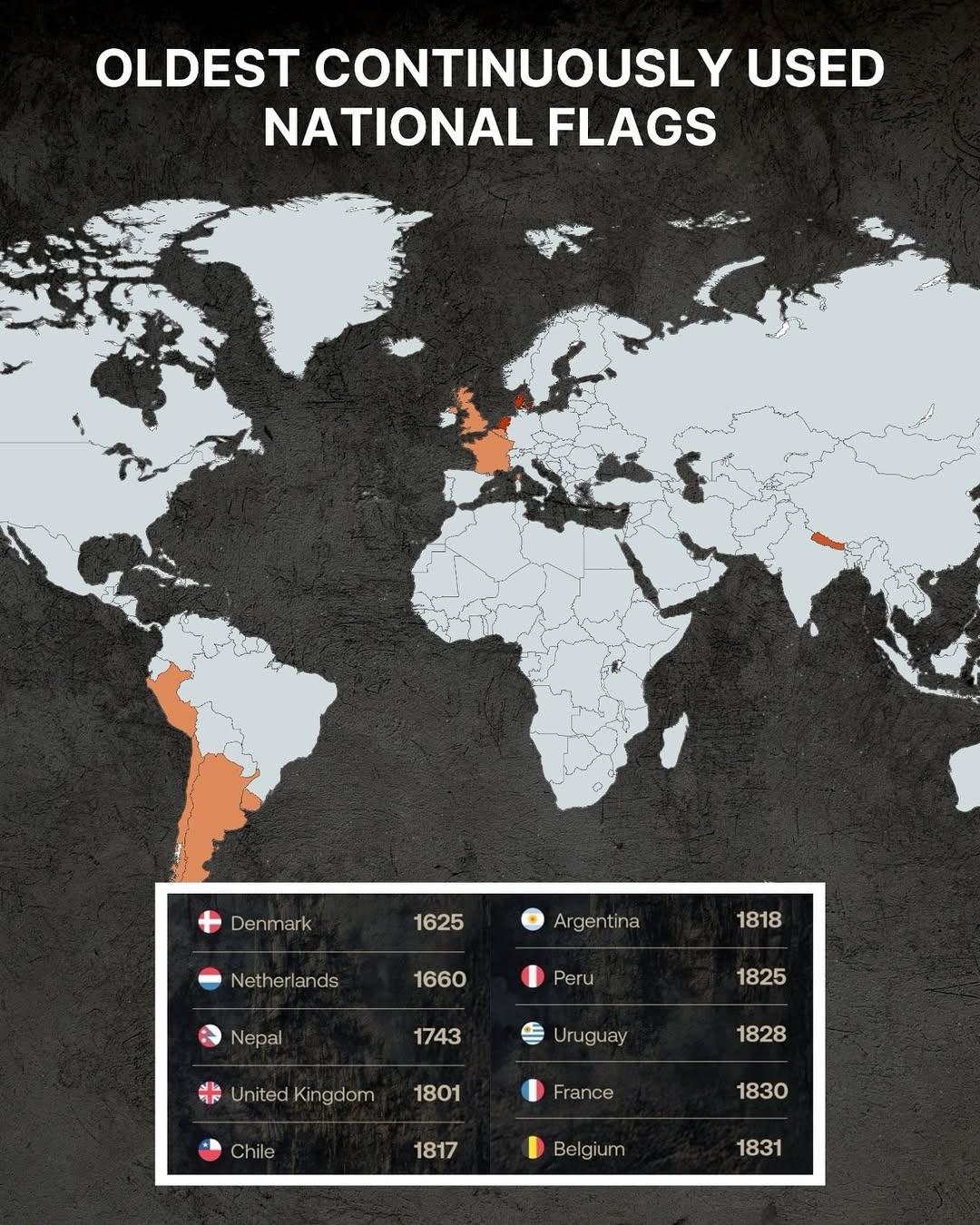Oldest Continuously Used National Flags Map


Marcus Rodriguez
Historical Geography Expert
Marcus Rodriguez specializes in historical cartography and geographic data analysis. With a background in both history and geography, he brings unique...
Geographic Analysis
What This Map Shows
This engaging map highlights the countries that boast the oldest continuously used national flags in the world. A national flag is a powerful symbol, representing a nation’s identity, history, and values. The visualization specifically draws attention to those flags that have remained unchanged or have only undergone minor modifications throughout the years, showcasing the rich tapestry of historical continuity in national representation.
Deep Dive into National Flags
Flags have been used for centuries, serving not only as banners of allegiance but also as representations of sovereignty, culture, and pride. The oldest flags, some dating back to the Middle Ages, have fascinating stories behind their designs and uses.
For instance, the national flag of Denmark, known as the Dannebrog, is often cited as the oldest national flag still in use. Legend has it that it fell from the sky during a battle in 1219, giving the Danish forces a significant morale boost. The flag features a simple design of a white cross on a red background, which has inspired many other Nordic countries' flags. Interestingly, the Scandinavian countries share similar flag designs due to their historical ties, which leads to a sense of unity among them.
Another noteworthy flag is that of Scotland, the Saltire, which features a white cross on a blue background. The Saltire is believed to have been in use since the 9th century, making it a significant emblem of Scottish heritage. The flag’s design is said to commemorate the martyrdom of Saint Andrew, the patron saint of Scotland, and has become a pivotal symbol of Scottish nationalism.
The flag of the Netherlands is also among the oldest, with its tricolor design of red, white, and blue dating back to the 16th century. Initially, the colors were orange, white, and blue, but as the orange faded into the red, the current color scheme became established. This flag not only represents the Dutch people but also holds a significant place in maritime history, often seen in various naval contexts.
The continuity of these flags reflects not only the history of the nations they represent but also the evolution of national identities over time. Flags are often revised or redesigned in response to political changes, wars, or revolutions, making those that remain unchanged all the more significant.
Regional Analysis
The map reveals a clear geographical distribution of these historical flags, with a notable concentration in Europe. Scandinavian countries such as Denmark, Sweden, and Norway showcase their ancient flags, highlighting their shared Viking heritage and long-standing traditions.
In contrast, many countries in Africa and Asia have undergone numerous changes to their national symbols, often reflecting colonial histories or modern political shifts. For example, the flags of many African nations were adopted or modified during the process of decolonization in the mid-20th century. This contrasts sharply with European countries where flags have maintained their designs for centuries.
Interestingly, the flag of Japan, with its simple yet profound design featuring a red circle on a white background, has been in use since the 7th century, representing the sun. This stark simplicity contrasts with the more elaborate designs seen in other nations, yet it conveys a deep cultural significance that resonates with the Japanese identity.
The regional variations in flag designs also tell us much about historical influences. In Central and Eastern Europe, for example, countries like Poland and Hungary have flags that reflect their complex history, with colors symbolizing various aspects of their national identities.
Significance and Impact
Understanding the oldest continuously used national flags provides insight into the cultural and historical narratives of nations worldwide. These flags serve as reminders of the past, representing struggles for independence, national unity, and cultural pride. They can evoke strong emotions and foster a sense of belonging among citizens.
Moreover, as globalization progresses, the significance of traditional symbols like flags becomes even more pronounced. While modern influences may lead to rebranding and design changes in many contexts, the enduring nature of these historical flags speaks to a desire for stability and continuity amidst change. With the rise of nationalism in various parts of the world, flags are increasingly seen as symbols of identity and resistance against homogenization.
In conclusion, this map not only showcases the oldest flags but also invites us to consider the importance of national symbols in our interconnected world. As we look to the future, it will be intriguing to see how these flags continue to evolve and what new stories they will tell.
Visualization Details
- Published
- August 12, 2025
- Views
- 102
Comments
Loading comments...